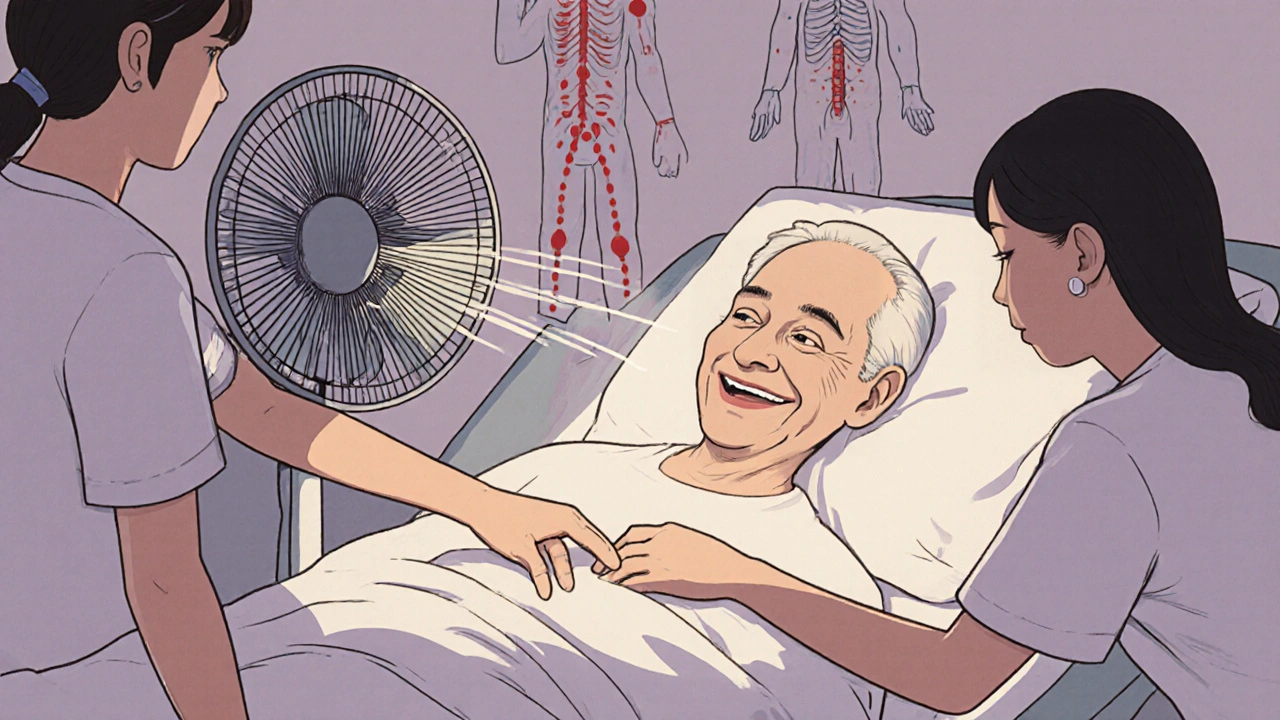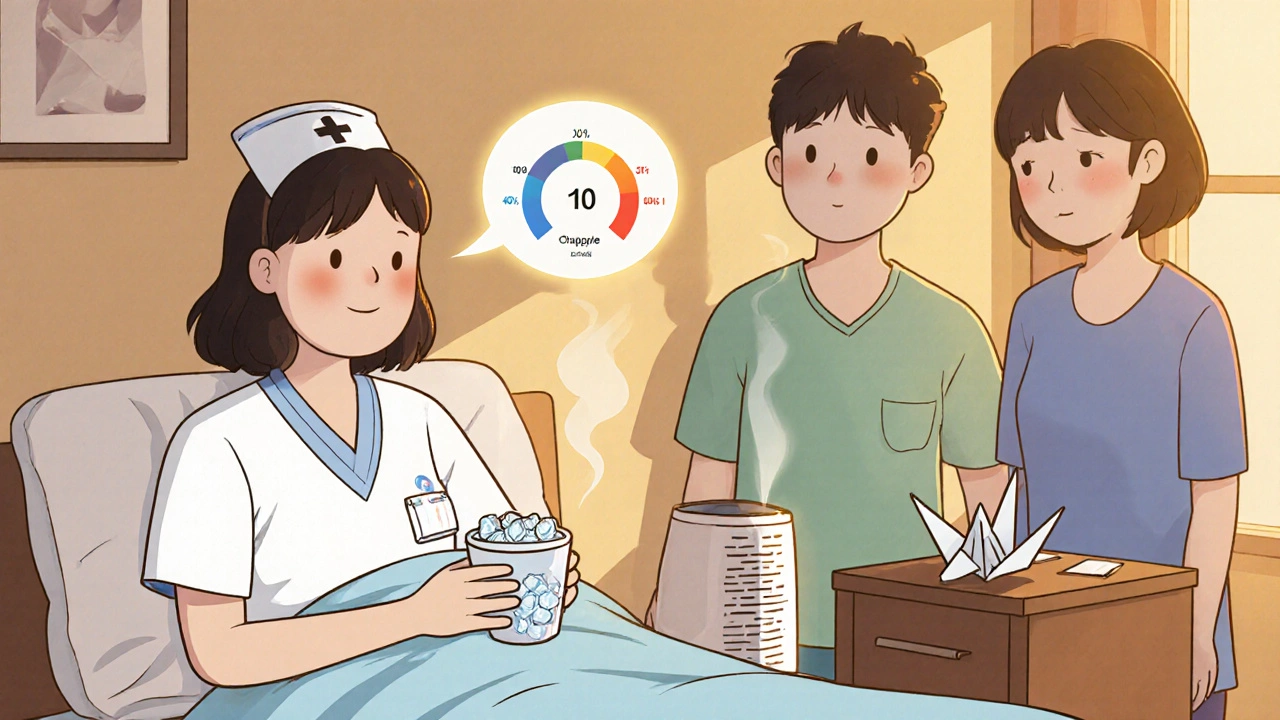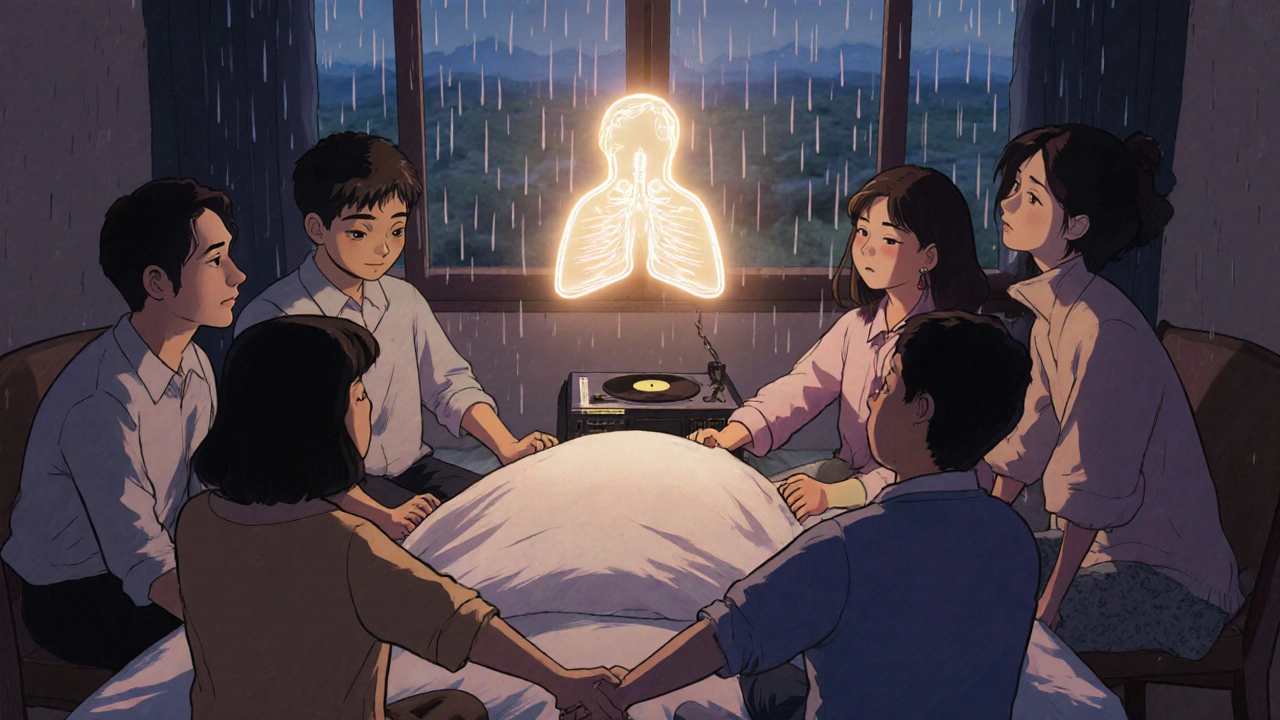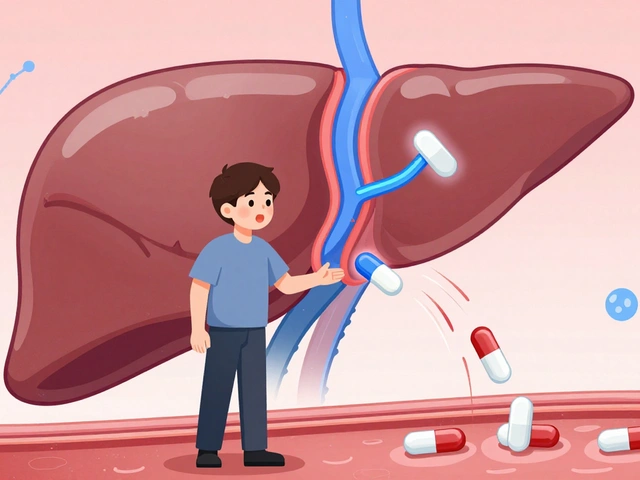
Pain Relief & Sedation Risk Calculator
Understanding the Balance
The biggest worry families and clinicians have isn't whether the pain will be controlled — it's whether the person will be too drowsy to talk, hug, or even recognize loved ones. Opioids like morphine are the gold standard for pain and breathlessness, but they can cause drowsiness, constipation, and confusion. The trick isn't avoiding them. It's using them smartly.
Estimated Outcomes
Pain Relief
Sedation Risk
What Palliative and Hospice Care Really Means
Palliative care isn’t just about giving pain meds before someone dies. It’s about helping people live as well as possible with serious illness - no matter how far along they are. This includes managing pain, nausea, shortness of breath, anxiety, and even feelings of hopelessness. Hospice care is a kind of palliative care, but only for those with six months or less to live who’ve decided not to pursue treatments meant to cure. Both focus on comfort, dignity, and quality of life - not just surviving, but feeling human.
Many think palliative care is only for cancer patients. It’s not. It helps people with heart failure, lung disease, dementia, kidney failure, and more. The key is this: you don’t have to stop treatment to get palliative care. You can be getting chemotherapy or dialysis and have a team helping you manage side effects, sleep better, and talk through fears.
The Core Challenge: Relief Without Over-Sedation
The biggest worry families and clinicians have isn’t whether the pain will be controlled - it’s whether the person will be too drowsy to talk, hug, or even recognize loved ones. Opioids like morphine are the gold standard for pain and breathlessness, but they can cause drowsiness, constipation, and confusion. The trick isn’t avoiding them. It’s using them smartly.
Doctors use a simple 0 to 10 scale to measure pain. But it’s not enough to just ask, “How much does it hurt?” You need to know where it is, what makes it worse, whether it wakes them at night, and if it stops them from eating or moving. The NHS guidelines say every type of pain needs its own assessment. Someone might have bone pain from cancer, nerve pain from diabetes, and muscle cramps from immobility - each needs a different approach.
For breathlessness, opioids help - and the evidence is solid. But they’re not the only tool. Positioning the person upright, using a fan on the face, or even oxygen (if they’re not hypoxic) can make a big difference. Sometimes, a little lorazepam helps with the panic that comes with not being able to breathe. But give too much, and they’ll drift off before saying goodbye.
Managing the Harder Symptoms: Delirium, Nausea, and Secretions
Delirium - sudden confusion, agitation, or hallucinations - is common in the last weeks of life. It’s often mistaken for dementia or just “being old.” But it’s usually caused by things like infection, dehydration, or drug buildup. The UPenn Comfort Care Guidelines say to check for it every 12 hours using the CAM tool. If it’s there, haloperidol is the first drug tried. But here’s the catch: you stop it once the person is calm. No need to keep giving it if they’re resting peacefully.
Nausea and vomiting are tricky. Sometimes it’s from the cancer itself. Other times, it’s from opioids or kidney problems. The best approach? Try a mix of drugs. Metoclopramide helps with stomach emptying. Ondansetron blocks the brain’s nausea center. Dexamethasone, a steroid, helps with bowel obstructions - and studies show it works better than expensive drugs like octreotide.
Excessive secretions - that gurgling sound near the end - are common and distressing for families, even if the patient doesn’t notice. Atropine drops or glycopyrrolate can dry them up. But they’re not always needed. Sometimes, just repositioning the head or suctioning gently is enough. Don’t rush to medicate unless it’s causing real discomfort.

Why Protocols Differ - and What Works Best
Not all guidelines are the same. The NHS in the UK has a 48-page pain assessment form. It’s thorough, but it takes time. Fraser Health in Canada uses shorter checklists - easier for busy nurses, but they miss some nuance. Dana-Farber breaks symptoms into separate books: one for pain, one for nausea. The National Coalition for Hospice and Palliative Care (NCHPC) gives the broadest view - covering not just physical symptoms, but spiritual distress, family grief, and social isolation.
What works best? Start with the NCHPC framework. It’s the most complete. But adapt it. If you’re in a nursing home with 15 patients and one nurse, you can’t do a full 48-page assessment on each. Focus on the essentials: pain score, breathing, level of alertness, and whether they’re eating or drinking. Use the body diagram - a simple drawing of a person where patients point to where it hurts. One study showed it improved communication by 31%.
And remember: guidelines are tools, not rules. They say “use morphine,” but they don’t say “give 10 mg every 4 hours.” Titration matters. Start low. Go slow. Watch for drowsiness. Reassess every hour when you adjust a dose. If they’re sleeping but still breathing easily and their face is relaxed - that’s success.
The Hidden Struggles: Spiritual Pain and Family Guilt
Physical symptoms get the most attention. But the deepest suffering is often invisible. A patient might say, “I’m not in pain,” but then whisper, “I’m a burden.” Or, “I don’t want to die alone.” This is existential distress - and it can make physical pain feel worse.
Dr. Harvey Chochinov’s research shows that when people feel their life has meaning, their pain perception drops. A chaplain doesn’t need to preach. Just listening. Asking, “What’s been hardest for you?” or “Is there something you need to say before you go?” can ease suffering more than any pill.
Families often feel guilty for wanting relief. They think, “If I let them have more morphine, am I killing them?” That’s why education is part of care. Nurses and social workers need to say plainly: “We’re not ending life. We’re making sure the last days are peaceful. The goal isn’t to keep them awake - it’s to keep them comfortable.”
What You Can Do - Even If You’re Not a Doctor
You don’t need to be a clinician to help. Here’s what actually works:
- Keep a symptom log: note when pain spikes, when they’re sleepy, when they refuse food.
- Use a humidifier or fan - it helps with breathlessness more than people realize.
- Offer ice chips or wet sponges for dry mouth. No need for fancy sprays.
- Play music they love. Or read aloud. Or just sit quietly holding their hand.
- Ask the hospice team: “What’s the next step if this gets worse?” Get the plan in writing.
One woman in Birmingham told me her husband stopped eating for three days. She was terrified he’d starve. The hospice nurse said, “His body is shutting down. Forcing food now would make him sick.” She cried - then held his hand and sang to him. He passed peacefully two days later.

What’s Changing in 2025
Palliative care is evolving. More people are using telehealth to talk to specialists without traveling. Rural areas still lack services - 55% of rural U.S. counties have no palliative team. But by 2027, that could drop to 30% with virtual visits.
New research is looking at genetics. Some people metabolize morphine faster. Others are more sensitive. In the future, a simple blood test might tell your doctor the right starting dose - no trial and error.
And non-drug options are getting more attention. The NIH is spending $47 million on studies for music therapy, massage, mindfulness, and even guided imagery. These aren’t “alternative” - they’re part of the plan. One study found patients using guided breathing reduced their opioid use by 37%.
But the biggest change? Timing. More hospitals are starting palliative care when someone is first diagnosed - not when they’re near death. People who get it early live longer, have less pain, and spend less time in the ER. That’s not a miracle. It’s good medicine.
Final Thought: It’s Not About Dying - It’s About Living
Palliative and hospice care aren’t giving up. They’re choosing a different kind of victory. One where the last days aren’t filled with needles, tests, and confusion - but with quiet, presence, and peace. The goal isn’t to fix the body. It’s to honor the person inside it.
Every dose of medicine, every conversation, every held hand - it all adds up. And when done right, it doesn’t shorten life. It makes it matter.
Is hospice care only for cancer patients?
No. Hospice care is for anyone with a terminal illness and a prognosis of six months or less - including heart failure, COPD, advanced dementia, kidney failure, ALS, and more. The focus is on comfort, not cure, regardless of the diagnosis.
Does using morphine mean the end is near?
Not necessarily. Morphine is used for pain and breathlessness at any stage of serious illness. Many patients start it weeks or even months before death. It doesn’t cause death - it relieves suffering. The dose is carefully adjusted to keep the person comfortable, not sedated.
Can palliative care be provided at home?
Yes. Most palliative and hospice care happens at home - with visits from nurses, social workers, and chaplains. Equipment like hospital beds, oxygen, and suction machines is provided. Families get 24/7 support. This is often preferred over hospital stays because it’s familiar and less stressful.
What if the family disagrees about treatment?
Hospice teams are trained to mediate these conversations. They don’t take sides. They help families understand what the patient’s goals are - not what the family fears. Sometimes, a simple video of the patient saying, “I just want to be comfortable,” changes everything. The goal is always to honor the patient’s wishes, not family guilt.
Are there alternatives to opioids for pain?
Yes. For nerve pain, gabapentin or pregabalin help. For bone pain, radiation or bisphosphonates may be used. For inflammation, steroids like dexamethasone work well. Non-drug options include heat, massage, positioning, and distraction techniques. But for moderate to severe pain, opioids remain the most effective - and they’re safe when monitored properly.
How do I know if my loved one is in pain if they can’t talk?
Look for signs: grimacing, clenched fists, restlessness, moaning, pulling at IV lines, or refusing to be touched. Use the PAINAD scale - a simple tool that scores breathing, vocalization, facial expression, body language, and consolability. Nurses are trained to spot these cues. Don’t wait for them to say something. Act on what you see.
What happens if I give too much medication?
Overdosing is rare when care is managed properly. Medications are titrated slowly, with frequent checks. If someone becomes too drowsy, the team will reduce the dose. The goal isn’t to keep them awake - it’s to keep them comfortable. If they’re breathing easily and their face is relaxed, they’re not overdosed. Fear of overdose often leads to undertreatment - which causes more suffering.
Is palliative care covered by insurance?
Yes. In the U.S., Medicare covers hospice care fully and palliative care consultations. Most private insurers cover both. Medicaid and VA benefits also include these services. There’s usually no copay for medications or equipment provided by the hospice team. Check with your provider, but don’t assume it’s too expensive - most costs are covered.
Next Steps If You’re Facing This
If you or someone you love is dealing with a serious illness, start by asking: “Can we get a palliative care consult?” Don’t wait until things get bad. The earlier you bring in the team, the more control you have over how the days unfold.
Call your doctor. Ask your hospital’s social worker. Look up your local hospice provider. You don’t need a referral from an oncologist. You just need to ask.
And remember: comfort isn’t surrender. It’s the most powerful kind of care there is.
11 Comments
Write a comment
More Articles
How to Maintain a Healthy Weight with a Skeletal Muscle Condition
Maintaining a healthy weight with a skeletal muscle condition can be challenging, but it's not impossible. It's essential to focus on a balanced diet, including plenty of fruits, vegetables, lean proteins, and whole grains. Regular, low-impact exercise like swimming, yoga, or walking can help strengthen muscles and improve overall fitness. Don't forget to consult with your doctor or a physical therapist to create a tailored exercise plan that suits your specific needs. Finally, remember to monitor your progress and listen to your body to ensure you're making consistent, healthy choices.

Statin Medications: What You Need to Know About Cholesterol Benefits and Muscle Pain Risks
Statins lower cholesterol and prevent heart attacks, but muscle pain is a common concern. Learn who benefits most, how to manage side effects, and why quitting can be dangerous.

10 Alternatives to Propecia: What Actually Works for Hair Loss?
Exploring life beyond Propecia? This article dives into ten practical alternatives for tackling hair loss, breaking down how each one works, their benefits, and their drawbacks. From prescription meds to scalp massages and creative DIY approaches, you'll find honest insights for every option. The article balances scientific facts with real-world experience, making it easy to figure out what might really work for you. By the end, you'll have a clear perspective on what's out there—no fluff, just solid advice.
Jacob McConaghy
November 25, 2025 AT 13:19Man, this post hit different. I watched my dad go through this with lung cancer, and the biggest thing nobody tells you? It’s not about the meds-it’s about the silence between breaths. The way his hand gripped mine when the morphine kicked in just right. No words needed. Just presence.
We had a fan pointed at his face at night. Didn’t need oxygen. Just air. Funny how something so simple works better than half the pills.
And yeah, the secretions? Scary as hell for family. But the nurse said, ‘That’s not him suffering-that’s his body letting go.’ We wiped his chin, repositioned his head, and let it be. He didn’t even flinch.
People think hospice is giving up. Nah. It’s choosing to stop fighting the tide so you can actually be with the person before they’re gone.